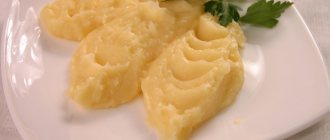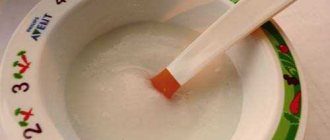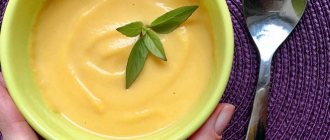What is better to start fruit complementary foods with: juice or puree? Which puree is better - homemade or store-bought?
Loving parents strive to give their child the best. They watch with joy and excitement as their baby grows up. And, of course, new questions arise every day: What is best for the first feeding? How should you prepare baby food? And if this is the first child in the family, then it becomes clear that this cannot be done without expert advice.
In addition, each child is unique, has its own individual characteristics of growth and development. Therefore, the best advice on feeding a baby can only be given to parents by a pediatrician who is seeing the baby.
Where to start?
Previously, complementary feeding began with juices and fruits. Now experts advise introducing vegetables or cereals into your baby’s diet, and only then fruits. This is explained simply: fruits are sweeter. And a child, having become acquainted with a sweet product, can then refuse more bland ones. If complementary foods are introduced after six months, it doesn’t really matter whether you started with porridge or vegetables. Your choice. Traditionally, vegetables are introduced first. If a child has previously had prolonged colic or diathesis, doctors recommend starting complementary feeding no earlier than six months and only with cereals. Vegetables and fruits have a stronger effect on the microflora and can cause colic and bloating. For the first two months, only monocomponent (consisting of one component) products are introduced, then they can be mixed.
Canned or natural?
One can argue endlessly about the need and usefulness of canned and natural nutrition. But the priority remains convenience for mom. If you prefer to feed cans and boxed cereals: feed, and don't look back. The only thing you need to pay attention to is: read the ingredients. For the first complementary feeding, food that does not contain unnecessary additives (sugar, salt, spices, milk or cream) is suitable. While doctors don’t have a common opinion about canned food, almost everyone agrees on the benefits of commercial porridges. They are easy to use and will be easier for your baby to understand. Not every mother has time to grind cereal in a coffee grinder. In addition, children's cereals are additionally fortified. A child can choose to eat them at least up to three years of age.
Of course, canned food contains fewer vitamins than natural food, because... is boiled down. Sterile. That is why it is stored for a long time. There is simply nothing to reproduce there in sterile conditions. But after opening, the jars are stored for no more than a day. Baby cereals are used only 3-6 weeks after opening; they quickly become enriched with harmful microorganisms from the air.
It happens that complementary foods need to be introduced in late autumn, winter or early spring, when all vegetables and fruits are pumped with chemicals. Fresh vegetables and fruits are rich in vitamins only in “their” season. Several months of storage - even with compliance with all standards, which, unfortunately, is extremely rare - and besides fiber and starch, little remains in them. In winter conditions, complementary feeding begins with canned vegetables. It is better to use a canned zucchini than an imported zucchini and a canned pear rather than a “conference” shiny with paraffin. They provide only canned meat; you will not find environmentally friendly meat for the first complementary feeding (and for the second and third) anywhere. Unless you live in a village and are absolutely confident in meat from your own rabbits - or trusted friends will give you a gift.
“Canned food – it remains to be seen whether acid rain is watering their fruit! And your natural diet contains a lot of nitrates! And in your jar there is modified starch, here! And your “rejuvenating” apples with paraffin…” Trust your intuition! Don't get involved in squabbles. Feed your baby the way you feel comfortable and what feels right to you.
* When indicating the recommended age on the packaging, baby food manufacturers act exactly according to the instructions, and they have not changed since 1997. There is no need to blindly trust the picture when buying all juices for a 4-month-old child with the indication “from 4 months”. Some foreign manufacturers come across bizarre compositions of canned food recommended for children under one year old: here there is pasta with meat, and spices. In a word: if mom is a person, she must have a head. And if she has a head, she should have smart thoughts: what SHOULD be given to her child, and not what was recommended 11 years ago according to instructions designed for artificial children.
Expert comments
Natalya Kustlivaya, chief physician of the non-profit organization “Mom + Baby”:
It seems to me that the problem “banks are not banks” is far-fetched. The main reason why you need to prepare fruit purees and juices yourself is vitamins. They are the first to be introduced into a child’s diet to correct vitamin and mineral deficiencies, which can develop in artificial babies by five to six months and after six months in breastfed children. It is known that all canned foods undergo heat treatment, during which vitamins are destroyed. Thus, vitamin C oxidizes upon mere contact with air, even without exposure to heat.
In addition, prepared fruit juices and purees may be subject to additional processing to remove nutrients that can cause allergic reactions. Take, for example, the Peach-Passion Fruit puree: a four-month-old baby may be allergic to exotic passion fruit. Therefore, manufacturers, hedging their bets, often dilute the product. Of course, you can use canned fruit purees and juices, but only in exceptional cases, for example, when traveling or visiting, when it is impossible to prepare complementary foods under aseptic conditions.
Homemade juices and purees should be given within 10 minutes after preparation; later the process of oxidation of vitamin C begins and it is destroyed.
A completely different matter is vegetables, which we value for minerals (iron, potassium, magnesium), fiber, and dietary fiber. Factory processing does not affect their content. The decision is up to the mother - let her do whatever is more convenient for her. You can cook from frozen vegetables, but at the same time check whether genetically modified components are used.
Most pediatricians are against feeding small children meat from the market. There are a number of diseases that have become known in the last few years. For example, borelliosis is a disease caused by tick bites, which also affects livestock. Moreover, if examination for tick-borne encephalitis is carried out free of charge, then examination for borelliosis costs money. It is clear that private farms are in no hurry to do this. Meat for canned baby food undergoes veterinary control.
The main thing is to pay attention to the age for which the food is intended. There is no need to be afraid of supplements: the same salt is officially recommended starting from seven months, and there is nothing wrong with that. Additives such as pectin or starch are also safe - these are complex carbohydrates that only promote digestion. If we talk about porridges, then, in my opinion, factory-made porridges, which only need to be diluted with warm water or milk, are preferable. Cereals are valuable not only for dietary fiber and complex carbohydrates, but also for vitamin B, which is destroyed during cooking.
Elena Marushenko, pediatrician at the Health Clinic:
In the debate about which complementary foods are better to give to the baby - ready-made in jars or homemade purees, I will not categorically deny either one or the other: it all depends on the time of year. If you are going to make puree from vegetables and fruits that you have grown yourself, then from July to January you can safely feed your baby with it. Of course, a lot depends on storage conditions, but, as a rule, starting in January, there is nothing left in our vegetables and fruits: for example, after six months there is nothing useful in potatoes except fiber. Therefore, from January until the first harvest, you can and should give canned complementary foods. You can, of course, make mashed bananas, but you should think about the feasibility - after all, it is known in what form bananas are plucked from the tree. And, by the way, it is very difficult to squeeze juice out of beautiful imported apples. If you are prejudiced against jarred purees, then buy frozen vegetables and fruits - vitamins are preserved there to a greater extent. In my opinion, freezing from domestic producers is preferable.
(source: www.eda-life.ru)
!It is important! Until the age of three, a child receives food intended only for children. All products must be marked “for baby food.” Pay attention to this. Very often sellers mislead the buyer. For example, on 0.5 packs of “children’s” juice, which is in a row of children’s juices, you will not see the inscription “for children from so many months.” This is NOT a children's juice because it cannot be sold in such a large package. Manufacturers of children's curds are also disingenuous. If you are still buying 100-gram packs of cottage cheese, read for interest whether they indicate “children’s” or “for children.” For example, our local cottage cheese “Mu” is for children only in 50-gram packages. One hundred gram “Mu” contains a “curd product”, and it is NOT for children, and in principle it is NOT cottage cheese.
Which scheme to believe?
We already talked about this in the first part of the article: all schemes are individual. Find an adequate doctor so that he can write out an individual complementary feeding scheme for your child, and not the one designed for children of the entire planet who were born about 30 years ago (a typical sign of such a scheme: starting complementary feeding with a few drops of juice). For example, a quite pleasant scheme from pediatrician-gastroenterologist Nika Vadimovna Drozdovskaya (Family Clinic, Moscow) has been circulating on forums for a long time:
Give each new product for at least 7 days. Start with 1 tsp. and bring it back to normal within a week.
6 months
At about 12 noon (future lunch) - vegetables. “Squash” (zucchini-pumpkin) is still a type of pumpkin, and not our stripe - don’t give it away. Remove pumpkin and carrots. Leave everything yellow for later. Start with green. It's better to cook everything yourself. You can puree frozen vegetables.
Zucchini – frozen. Eg.
Cauliflower – “Semper” or frozen.
Broccoli - “Semper”, “Top-top” (not to be confused with “Tip-top”).
Green beans - make your own.
Green peas – “Gerber”.
Potatoes – “Gerber” ordinary, don’t give sweet ones (also not our style), do it yourself (pre-soak for 2 hours in boiled cold water, when starch is released, change the water).
Parsnips and spinach - after a year, something is washed out of the body, it seems like calcium - I won’t lie, I don’t remember. (comment by ptica_we: iron is washed away, just like parsley)
When you try everything, you can mix, but no more than 3 types.
Vegetable oil from 8 months.
7 months
At 17:00 (future afternoon snack) – fruits: Green apple – “Semper”, “Top-top”. Bake it yourself. Red later. Pear - (if there is no constipation) “Semper”. We personally are allergic to Gerber. Banana - make it yourself. Apricots, peaches - jars, do it yourself in the summer, do not water them with anything harmful, as for cherries - later, do it yourself in the summer. Recommended jars: “Gerber”, “Beach Nat”, “Semper”.
Porridge - give in full. At night (especially if you wake up at night to eat). Completely replace one feeding. Buckwheat, corn, rice without additives.
Oatmeal, semolina, milk, and soy porridges are not included in the diet for up to a year. It is harmful.
The packaging should say: “no sugar, salt, gluten, milk, dyes.”
It is best to give it in water, since with the addition of milk there is a greater burden on the gastrointestinal tract. If he doesn’t eat, add fruit puree, then milk (mixture) diluted with water.
“Gerber”, “Baby Sitter”, “Low-allergenic Baby”, “Hipp”
Cottage cheese - after 8 months. For an afternoon snack, add to fruit puree. Strictly no more than normal.
Meat - after 12 m. (load on the gastrointestinal tract) add to vegetable puree. Do not exceed the meat norm! Strictly prepared purees with vegetables. "Gerber" - turkey, pig, lamb, beef. Children should not be given meat broth until they are at least one year old. It contains too many carcinogens. They serve soup with vegetable broth.
Kefir - after 12 months (it has too high acidity, and in children with perinatal damage to the central nervous system (90% of children) there is already increased acidity of the gastrointestinal tract. Kefir in children under one year of age causes microbleeding in the intestines, which leads to severe hypochromic anemia. It is given for night. Bifi-kefir Agusha without sugar. If the child refuses, do not insist.
It is better to drink before meals, do not wash it down.
Juices diluted with water (min. 1/1), after a year.
Salt after a year, sugar, in general, the later, the better.
Always feed your child at your table, so that there are no distractions.
Do not snack between feedings - apples, bread, snacks.
In grams
7 months. Fruits – 60 gr., vegetables – 150 gr., porridge – 150 gr.
8 months. F. - 70, O. - 170, K. - 150
9 months. F. - 80, O. - 180, K. - 180
12 months. F. - 90-100, O. - 200, K. - 200.
So, let's go!
In what order should foods be introduced into the diet?
(for a breastfed baby without any allergic manifestations)
4-5 months (vegetables for lunch, porridge for breakfast)
1 week – zucchini
Week 2 – cauliflower
Week 3 – broccoli
Week 4 – a mixture of three already familiar vegetables + vegetable oil
Week 5 – buckwheat dairy-free porridge
Week 6 – dairy-free rice porridge
Week 7 – dairy-free corn porridge + teaspoon butter
Week 8 – pumpkin, fruit puree – apple, pear, prune
6 months (a new product can be introduced every three days)
Meat – rabbit, turkey, veal puree
Children's cookies
This was the base. Now the baby has a full breakfast and lunch and you can introduce other foods in approximately this order, gradually replacing evening feeding with dinner.
7 months
egg yolk
8-9 months
cottage cheese, kefir, potatoes, carrots, beets, white bread, fish puree (2 times a week instead of meat), juice
12 months
berry puree
Porridge
Porridge is given at 6-7 months with 1-2 teaspoons, gradually increasing the volume to 150 grams. It is optimal to use industrially produced cereals, the so-called instant ones, in feeding infants. They are enriched with vitamins and minerals, and a child under one year old should receive only fortified foods. Sometimes doctors advise starting complementary feeding with porridge according to individual indications: for example, a child has unstable stools, some kind of stomach problems, in which case vegetables and fruits will only do harm. The first to introduce gluten-free porridges without milk and sugar: rice, buckwheat or corn. Then - oatmeal. Mixtures of cereals are introduced closer to the year. Buckwheat is considered the healthiest porridge for a child, millet is the heaviest, and corn is the most “empty” porridge. There is no need for milk porridges up to a year.
We cook the porridge ourselves
Cooking porridge at home is also easy. The cereal can be pre-grinded in a coffee grinder to the state of flour, or the already prepared porridge can be broken in a mixer until a homogeneous mass is obtained. It is better to cook the cereal in water, and immediately before feeding, add 20-30 ml of breast milk or the formula that the baby usually eats. This will improve the taste of the dish and make it more “familiar” for the child.
Best Recipes
We invite you to get acquainted with the best recipes for making fruit puree for babies at home.
Applesauce
- Take high-quality ripe fruit.
- Prepare it for cooking - wash it, pour boiling water over it, peel it, remove the seeds, cut it into slices.
- Place the apple pieces in a small saucepan, pour in 0.5 tbsp. water.
- Bring to a boil, reduce heat and simmer for 10 minutes.
- Cool, chop - mash thoroughly with a fork, grind through a sieve or using a blender.
Apricot puree
- Wash the apricots and pour boiling water over them.
- Place the fruits in a sieve, dividing them into halves and removing the seeds.
- Steam for 10 minutes.
- Cool, remove the skin and rub through a sieve.
Collection of popular misconceptions
1. “If the child is low birth weight, you need to introduce porridge as early as possible.” As surveys on mother's websites show, out of hundreds of children, 2% of children gain weight from the introduction of cereals. If a child is really behind in weight (not by 100-500 g from the norm, but by at least 2 kg), you need to understand the reasons, and not fatten him up like a pig.
2. “Porridge at night promotes long sleep.” There is no scientific evidence for this folk wisdom. In the time of grandmothers, children were fed semolina porridge with butter and sugar at night. It’s no wonder that after such a carbohydrate hit, the child slept all night, stunned. We no longer live in the last century and understand that such a cocktail at night is very harmful. However, you can give your child thin porridge for dinner so that he doesn’t want to eat at night; small children tend to feel hungry at night.
3. “Children’s cereals are less healthy than homemade ones.” If you have time to grind cereal in a coffee grinder, and your child eats this porridge well, great. But it is better to feed a child up to one year only with fortified foods. Because he has an actively growing body. And vitamins are always in place.
What additives may industrial baby cereals contain:
Maltodextrin is a mixture consisting of glucose, oligosaccharides and malt sugar. Improves digestion, helps increase insulin, and gives the porridge a natural sweetness.
Glucose, dextrose - fruit sugars, dextrose - grape sugar.
Vanillin is an odorous substance from the vanilla fruit. Unfortunately, manufacturers often use synthetic vanillin without specifying it. Vanillin may be an allergen.
Industrial cereals suitable for first feeding (without sugar and other additives): HEINZ (hypoallergenic series with a hippopotamus in a robe on the box), Hipp, BabySitter, Nutricia (Malyshka, Top-Top).
Fruits
Fruit complementary foods traditionally start with a green apple or pear. They need to be baked: the allergenic properties will go away, but beneficial pectin will be released, which cleanses the body. A month later, plum is introduced. Exotic fruits are offered later due to possible allergic reactions, as well as to ensure that sufficient enzymes are accumulated to digest them. Bananas, peaches, and apricots are introduced no earlier than 9 months. We try citruses closer to the year; grapefruit and pomelo are considered the least allergenic. Why exactly this sequence of introducing fruits? Imagine apple puree, pureed in a blender. And now the same banana puree. Feel the difference. A fibrous and starchy banana is much heavier, more viscous, and less digestible. Plum has a laxative effect, so it is also introduced only after the child has tasted it and is accustomed to the fruit.
Fruits are introduced in the same way as vegetables: from ½ teaspoon, gradually increasing the norm to 40 g. Up to three years, the daily norm of fruit is 100 g per day.
What fruits should you start complementary feeding with?
If you start feeding your baby vegetable purees after the fourth to sixth month, then fruits should be introduced correctly from seven to eight months of age. Green apples and pears can be offered as the best complementary foods. After a month, you can expand the list by adding banana, prunes, apricots, plums and peach.
It is necessary to take into account the properties of each fruit or berry, each time choosing the most suitable recipe for it.
Banana delicacy needs to be prepared in smaller quantities, because it has a lot of calories. It is useful because it is rich in magnesium and potassium.
Plum has a mild laxative effect that improves intestinal motility. In addition, such puree is a source of thiamine and riboflavin - B vitamins. It has a diuretic effect, removes excess bile, cholesterol and carcinogens. But too high a dose can cause diarrhea.
Blueberries are one of the most necessary components of the diet. It contains tannin, which acts as an anti-inflammatory and intestinal disinfectant. The pectins in its composition absorb harmful substances, and beta-carotene (provitamin A) strengthens and supports vision. Manganese contributes to the formation of the body's energy reserves - liver glycogen, improves the processes of hematopoiesis and growth.
Apricots are a real storehouse of potassium, pectin, carotene and vitamin C. They are very useful for anemia and constipation, destroy putrefactive microorganisms in the intestines and help remove sputum from the lungs when coughing.
Pear is a fruit that has a fixing property. It is useful for children prone to frequent diarrhea and intestinal disorders.
Blackcurrant is a low-allergenic product, a record holder for the content of vitamins C and P. In addition, it contains potassium, pectins, fruit sugars and acids. Has diaphoretic and anti-inflammatory properties.
Dairy products
A scientific study conducted at the Research Institute of Nutrition of the Russian Academy of Medical Sciences showed that the early introduction of kefir or milk into the diet of infants can lead to a loss of iron in their body. Kefir is characterized by high acidity, a coarse curd structure, and the content of alcohol and yeast cells. Kefir contains a lot of “coarse” casein protein, which is not only difficult to digest, but also unbalanced in amino acid composition. The fat composition of kefir is not diverse enough, and the ratio of fatty acids in this product is not physiological for the baby’s body. Kefir carbohydrates are not at all similar to those present in breast milk or its artificial substitutes, and it contains much more mineral salts. Therefore, kefir is administered no earlier than 6-8 months and no more than 200 ml per day - and does not replace breast milk or formula. Many pediatricians advise introducing fermented milk products only by the age of one year, if the child is healthy and gaining weight well.
Special children's yoghurts (such as "Agushi") can be offered to a child aged 10 months or older. The amount of yogurt at one year of age: no more than 100 ml.
They begin to try cottage cheese from 8 months, or even later. For a child who consumes breast milk or formula in sufficient quantities, cottage cheese is simply not relevant. In the first year of life, you should not give your child more than 25 - 40 grams of cottage cheese per day. Cottage cheese contains heavy protein. Protein breakdown products are excreted by the kidneys. When bottle-fed, the immature kidneys of an infant may not be able to cope with the excessive protein load that occurs if the child consumes cottage cheese in quantities exceeding those recommended. It is known that excess protein load in the first year of life, especially with artificial feeding, can lead to atherosclerosis and arterial hypertension in the future. Alternatively, a child after one year can be given 100 g of cottage cheese every other day. These norms last for up to three years, remember: 100 g of cottage cheese per day is the norm for an adult.
There is no point in introducing cow's milk before one year of age. It contains little fat, protein denatured by pasteurization with a digestibility of less than 50%, a complete absence of iron and vitamins, excluding the lone artificial vitamin C. Modern pediatricians do not recommend introducing whole milk before a year, and it is better to replace whole milk with infant formula until 2-3 years of age. where the protein is in split form).
Meat
If the child began to be fed at six months, meat is introduced no earlier than 10 months. This is one of the heaviest products; meat takes a long time to digest, so there is no need to rush to introduce it. Begin administering with half a teaspoon. You can give this dose for three days and monitor the reaction. It is advisable to immediately mix the meat with the vegetable puree that you have already introduced. If the meat goes well, the volume increases to a spoon, two, etc., at 10 months a child can receive 30 g of meat, by a year - 40-50 g. 100-200 g of meat per day is the norm for an adult. It is not beneficial for a child to increase the amount of meat, taking into account the protein load (as a rule, a child up to one year old receives enough protein from GM or mixture).
Meat that is introduced BEFORE a year: rabbit, turkey, beef; AFTER a year, veal, chicken, pork and red fish are introduced. Meat broths are not used in children's diets; they contain harmful substances boiled from meat. The broth has the ability to be absorbed very quickly into the intestines; a child’s liver is not able to filter out all carcinogens. The kidneys also suffer: due to the huge amount of salts, urolithiasis can develop. Children's soup is cooked in vegetable broth without salt. You can add canned children's meat to it - you get a “broth”. Meat dishes prepared for children are not stored at all, they must be consumed immediately; the best time for meat is lunch.
If you prefer to buy meat in jars, choose puree made from one type of meat (mono-product) without adding spices and potato starch, marked “1st step”. Reheat canned meats immediately before use. An open glass jar with unused puree can be stored in the refrigerator for no more than a day. If introducing meat for the first time, look for the indication “homogenized” (finely ground) on the cans.
Juices
Previously, it was believed that breast milk is depleted by 6 months, and the baby needs to be given juices from five weeks as an easily digestible product rich in vitamins. Now we know: juices for a child under one year old are more likely a variety in the diet than a benefit. The introduction of juices before 4 months is not advisable, since it does not make a significant contribution to meeting the needs of children for vitamins and minerals, but often leads to allergies and disruption of the gastrointestinal tract. Juices with pulp are introduced no earlier than a year. Any juices must be diluted so as not to spoil the gastric mucosa. With the early introduction of juices, the pancreas does not “train”, as some lovers of early complementary feeding believe, but strains, trying to produce enzymes for digesting an unknown product. She won’t be able to do anything before the allotted time: the child develops enzymes for digesting fruits from the age of 4 months. It is recommended to start feeding fruits with puree as it is less aggressive for the intestines, because puree contains substances that protect the intestines from acids. Another myth: “a child from 3-4 months needs apple juice to increase hemoglobin.” Any hematologist will tell you: iron from plant foods is absorbed extremely poorly, even in adults.
According to modern recommendations, juices are introduced no earlier than 6 months from one teaspoon with a gradual increase in volume up to 100 g. Up to three years of age, children are given juices marked “baby food” on the packaging. Directly pressed juices can be offered to children from 1.5-2 years of age, if there are no medical contraindications. At the same age, freshly squeezed juices are given in the amount of 150-200 ml per day (half diluted with water), only if the baby does not have gastrointestinal diseases or allergic reactions. Keep in mind that industrial juices contain hidden natural preservatives: they add a small amount of grape juice - or red currant juice. Therefore, a child may be allergic to juice from one company, but not to the same juice from another company. Perhaps the first juice contained a hidden preservative, and the child reacted to currants or grapes.
Important nuances of introducing fruit complementary foods
The baby is fed a homogeneous puree of plant products, increasing its thickness and heterogeneity over time. To begin with, it is better to use a vegetable product from the most neutral hypoallergenic fruits - zucchini, cauliflower or spinach. And only after, when the child gets used to such food, fruit dishes are used. There are two reasons for this order:
- The taste of fruits is sweeter and richer, so after trying them, the baby may refuse to eat bland vegetables.
- Tree fruits contain more allergens than vegetables. And fructose can negatively affect the pancreas and kidneys of a child who is not accustomed to such stress.
However, after some time, when the baby has fully mastered vegetable complementary foods and gets used to them, fruit products should also be introduced. After all, they are sources of essential minerals and vitamins. But such puree is required approximately two times less than similar vegetables. Even later, the diet is replenished with meat and fish dishes - in exactly that order.
Even if a child happily eats fairly large portions of various purees, you should not deny him breast milk. It should be present in the diet for at least a year. Even if the baby no longer takes the breast, healthy mother's milk can be added to complementary foods. The very first option is generally better to cook with a sufficient amount of liquid, and subsequently the thickness of the dish increases.
And finally...
The child's body has a unique ability to regulate its needs.
Let us remember the popular saying “a child always knows what he needs.” If your child stubbornly refuses porridge, most likely he simply does not need it. He has enough nutrients. Nutritionists call children under three years of age clairvoyants in nutrition: children always know what they need. Of course, this does not apply to situations where they start sweetening a child with kefir and porridge very early, and then make excuses that the child eats “that’s the only way” or he doesn’t have enough glucose... Children will always prefer sweets, because breast milk or formula was their first food. sweet. Don't be upset if your child doesn't eat vegetables or fruits. He'll still have time. Perhaps he understands that he does not need them. Or, by your behavior, you provoked him into refusing behavior (feeding too early or nervous exclamations while eating, attempts to “push”). And if someone “drips on your brains”, scolding you for your “poor” son, who “still” does not eat meat or porridge - just answer: THE CHILD HIMSELF KNOWS WHAT HE NEEDS! And period.
In the third part of the article we will find out what OTHER products can be introduced BEFORE the year.
Useful links on the topic:
The third part: about butter, eggs, salt, sugar, etc. Let's introduce complementary foods! Part III: What other foods can be introduced before the year?
What to do if your child doesn’t eat enough:
The photo shows how to eat and how much you need to get dirty while doing it, yu-babies: 1. Yaroslava (mother ptica_we ); 2. Vityusha (mother of Olcha ); 3. Ivan (mother NANCY ); 4. Daniil (mother Blonde ).
Would you like us to calculate everything for you and offer a complementary feeding menu for a child over 6 months old? Take advantage of our FREE service:
Rules for introducing complementary foods from fruits
Based on the behavior and signs of the child’s development (after the fourth or fifth month), it can be assumed that he is ready to move to a new level of nutrition. This process should begin when the baby can already sit. During play, he actively “gnaws” on the toy, making chewing movements with his jaws. His weight is sufficient and is gaining steadily - within normal limits.
Puree should only be given freshly prepared, especially if it contains breast milk or a drop of butter. The only way to properly store the finished product is freezing. The mixture is poured into an ice mold or silicone container for small muffins and placed in the freezer. Before serving, it is thawed, heated strongly, and then cooled to the required temperature. Such a preparation should contain only the puree itself and water.
New products must be introduced according to certain rules:
- You should gradually let your baby try the puree, waiting until he wants to eat it. You cannot force a child to eat it. If a child is naughty, you can persuade him, cheer him up, and sing a song. During the first such experience, and subsequent ones, it is advisable to create a calm environment around the baby that does not distract the baby’s attention. If the attempt still fails, it is better to repeat it in the next few days. Usually, after two or three trials, the baby happily eats the offered complementary foods.
- You should not give a little person more than one new product at a time, because it is very important to evaluate the baby’s condition after taking each of them. Any fruit can cause allergies, indigestion and other diseases. It is very important to correctly determine which puree is to blame for the malaise, and not to give it to the baby in the future.
- The initial portions should be administered very small - one spoonful of puree at a time. Only then, when the harmlessness of a particular fruit becomes clear, should you increase the portions. Exactly the same principle is used to prepare mixtures from several options - all ingredients must be tested in advance.
- From the very beginning, the puree should consist of only one fruit - complex mixtures are less digestible, and it is also easier to trace a possible negative reaction to a particular complementary food.
- The difference between new fruits should be about one and a half to two weeks, so that his body gets used to the product. When giving a try to another new product, you can mix it with a small amount of a proven product - this will help the baby himself positively accept it, and his digestive tract will assimilate it normally.









